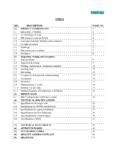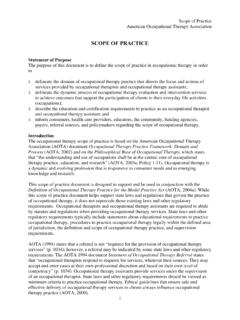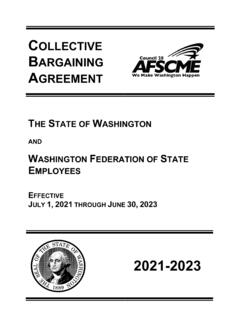Transcription of FUNDAMENTALS OF SAFETY AND ACCIDENT PREVENTION
1 FUNDAMENTALS OF SAFETY AND ACCIDENT PREVENTION BY SHARMA BSc, BE(FIRE),MBA(HRM), PDIS, NEBOSH(IGC) MANAGER(FIRE& SAFETY ) IFFCO KALOL UNIT I am a student of whoever I can learn from. I don t see myself in position like I M above anybody else and I can never learn or no one can ever teach me anything .. "The only thing that interferes with my learning is my education." The illiterates of 21st century will not be those who can t read, write or express but those who can not learn, unlearn and relearn .. SAFETY FIRST AAIYE SURAKSHA KA SHRIGANESH KAREIN Three essential ingredients in any Organization. Man, Machine Material These form three angle of a triangle with Management at center to control them. It is essential that this triangle is an equilateral triangle, maintaining the essential equilibrium.
2 MANAGEMENT MAN MACHINE MATERIAL A Machine can be programmed, Material flow can be controlled but Man can not be programmed or controlled in democracy like us. To expose to danger ,risk, chance of accidents, loss A hazard is any source of potential damage, harm or adverse health effects on something or someone under certain conditions at work. "Condition, event, or circumstance that could lead to or contribute to an unplanned or undesirable event." Table 1 Examples of Hazards and Their Effects Workplace Hazard Example of Hazard Example of Harm Caused Thing Knife Cut Substance Benzene Leukemia Material Asbestos Mesothelioma Source of Energy Electricity Shock, electrocution Condition Wet floor Slips, falls Process Welding Metal fume fever Practice Hard rock mining Silicosis Types of Hazard Physical Chemical Biological Ergonomics Physical Hazards Noise Vibration Radiation Temperature Pressure,Velocity,Height Electricity Physical characteristics Explosives Flammable liquids Corrosives Oxidizing materials Toxic, carcinogenic, substances Gases and air particulate Chemical Hazards Biological wastes (blood, fluids, etc.)
3 Drugs (antibiotics & others) Viruses, bacteria Parasites, insects Poisonous or diseased plants, animals Biological Hazards Physical Environmental Psycho-Social ergonomic Hazards Physical Poor work, task design Repetitive motion Prolonged sitting Poor layout Poor posture Improper lifting and handling ergonomic Hazards Environmental Poor lighting,glare Poor ventilation Poor temperature control Poor humidity control ergonomic Hazards ergonomic Hazards Psycho-social Work rest cycles Violence, discrimination Extraneous stress Un even work load Lack of personnel space Poor inter staff relationships A possibility of danger or harm What is risk? Risk is the chance or probability that a person will be harmed or experience an adverse health effect if exposed to a hazard. It may also apply to situations with property or equipment loss.
4 A Simple Risk Assessment R = (P) x (S) R = Risk P = Probability of occurrence / Likelihood S = Severity of effect (consequence) Difference between Risk & Hazard The term "risk" is often confused with "hazard". A high voltage power supply, a sample of radioactive material, or a toxic chemical may present a hazard, meaning that they present the potential for harm. Risk indicates probability of hazard causing the harm. It is thus evident that hazards are something we can do little about. The hazards posed by a carcinogen, a concentrated acid or an explosive substance are inherent properties of the material. The risks they pose, however, can be (and should be!) minimized by initially preparing a suitable risk assessment, and then by following the procedures laid down in that assessment. A quality or condition of being safe from danger, Injury, damage, loss, accidents WHAT IS SAFETY ?
5 IS IT FREEDOM FROM ACCIDENTS ?? IS IT REDUCTION OF ACCIDENTS ?? IS IT ALL ABOUT COMPLIANCE OF LEGAL REQUIREMENTS ?? INDUSTRIAL SAFETY MEANS CONTROL OF HAZARDS BY ABIDANCE TO BEST PRACTICES. DEGREE OF PROTECTION OF HAZARDS. CAN IT BE 100% ?? ANSWER TO THIS DEPENDS UPON THE DEFINITION OF THE TERM HAZARD HAZARD BASIC & INTRINSIC PROPERTY BY VIRTUE OF WHICH SOME THING OR SITUATION CAN CAUSE LOSS OR HARM. THIS PROPERTY BEING INTRINSIC, CAN NOT BE CHANGED. OUR KNOWLEDGE IS LIMITED BY EXPERIENCE. HAZARD As our knowledge increases with experience we try to apply better controls as well. Due to our limited knowledge we are constrained from using the term 100% safe. Hence we can say: Complete freedom from accidents is not possible. SAFETY does not mean Zero ACCIDENT . HAZARD CONTROL HIERARCHY ELIMINATION SUBSTITUTION ENGINEERING CONTROL ADMINISTRATIVE CONTROL PPE S BEST PRACTICES NATIONAL STANDARDS : BIS, OISD, TAC.
6 INTERNATIONAL STANDARDS : ILO,API,UL,NFPA,EN,OSHA,NIOSH MANAGEMENT SYSTEMS: ISO,OHSAS,DUPONT,BSC 5 STAR STATUTES VARIOUS ACTS & RULES BENCHMARKING WHY SAFETY IS REQUIRED ? MORAL ARGUMENTS Obligation, Duty Of Care Fatalities/Disabilities SOCIAL ARGUMENTS Loss to Society Sufferings LEGAL ARGUMENTS Labour Laws Penalty/Closure FINANCIAL ARGUMENTS Direct Cost Indirect Cost INCIDENT An event that could or does result in unintended harm to people and /or damage to property and/or environment. Incidents are divided into two categories. WHAT IS ACCIDENT AN UNINTENDED, UNPLANNED EVENT WHICH HAS THE POTENTIAL TO CAUSE HARM OR INJURY. AN INCIDENT WHICH CAUSES HARM OR HAS POTENTIAL TO DO SO. HEINRICH THEORY OF ACCIDENT CAUSATION INJURY IS THE RESULT OF COMPLETION OF 5 DOMINOS Environment.
7 Of the person Action / Unsafe Condition Domino no-3 Unsafe Acts & Unsafe conditions are the main contributory factor for ACCIDENT causation. Unsafe Acts 88% Unsafe Conditions 10% Others 2% It indicates that 98% of accidents can be prevented. Theories of ACCIDENT Causation 24000 600 Near Miss / Unsafe conditions 300 No Injuries Minor Injuries 1 24000 600 Near Miss / Unsafe conditions 300 No injury 29 Minor Injuries 1 LTI The above figures are averages. Injury can occur the first time also Should analyze root cause of problem than attacking the symptoms Theories of ACCIDENT Causation 24000 600 Near Miss / Unsafe conditions 30 Property Damages 10 Minor Injuries 1 Fatality Reporting and investigation of No injury accidents , Near misses can improve the SAFETY performance of a unit Frank Bird analyzed million accidents in 1969 Defects in the system Existence of Hazard Employees to error Associated Risk Accidents occur How do accidents occur ?
8 ? ACCIDENTS CAUSATION Today s thinking do not just happen, they are caused is not simply due to human or technological failure, but failure of Management Control Systems are due to uncontrolled events or activities is a mgt. Function to control all events/activities in its physical, technological and human aspects CAUSES OF ACCIDENTS ACCIDENT CAUSES INDIRECT CAUSE DIRECT CAUSE PHYSIOLOGICAL UNSUITABILITIES PHSYCOLOGICAL UNSUITABILITIES LACK OF KNOWLEDGE & SKILL UNSAFE ACT UNSAFE CONDITION Causes of ACCIDENT Direct Indirect Unsafe Act Unguarded or inadequately guarded machines / equipments Defective conditions of m/c s, equipments, tools etc. Unsafe methods of storing, piling etc. Inadequate or incorrect illumination Inadequate Ventilation Improper House Keeping-- things not at their proper places Unsafe design or construction of machines and equipment etc.
9 Operating without authority Bypassing SAFETY devices Operating at unsafe speed Using wrong tool / equipment Unsafe Placing Unsafe Loading Taking unsafe position or posture Working on dangerous or moving equipment Not using PPE Horse playing at work place etc. Causes Unsafe Condition Causes of ACCIDENT Physiological Unsuitability s Indirect Causes Poor eye sight Hard to hearing Intoxicated Physiological disabled Psychological Unsuitability's Negative attitude towards SAFETY Ignorance of SAFETY rules and procedures Frustration & Conflict Morale Individual differences Acclimatization Motivation & aspiration Boredom & monotony Lack of Knowledge & Skill` COST OF ACCIDENT DIRECT COST Insurance Claims Loss of Production or reduced output Product loss or damage Damage (plant, materials, premises) Sickness cover/ sick pay Medical treatment Repairs to plant & equipment Replacement of equipments Compensation Business opportunities, Share prices INDIRECT COST Business interruption Product liability Loss of orders Legal fees/fines/penalties Delay in production Start up cost Increased insurance renewal costs Training replacement Cancellation of orders Reduced productivity.
10 Overtime/additional wages Loss of profit Loss of corporate image Cost of time spent on Investigations Supervisors assisting victim Workers stopping to discuss the incident Preparation of reports Attendance on court proceedings Hospital visits & dealing with relatives The Cost of Accidents Iceberg analogy of costs Direct Cost Compensation Medical Expenses Equipment damage Indirect Cost Cost of Lost time Production loss Over head & administrative expenses etc. PRINCIPLE OF SAFETY MANAGEMENT Unsafe action / Unsafe condition & accidents are only the symptoms of some thing wrong in the SAFETY management systems . SAFETY should be managed like any other company function. The key to effective line SAFETY performance is management procedures that fix ACCOUNTABILITY . Reasons for ACCIDENT PREVENTION ACCIDENT PREVENTION 1 Humanitarian 4 Legal 3 Social 2 Economic How to achieve SAFETY ?


















